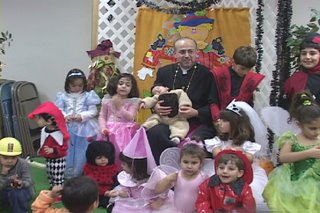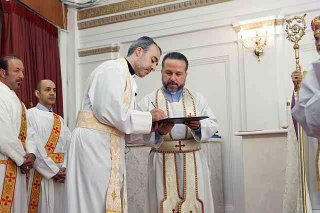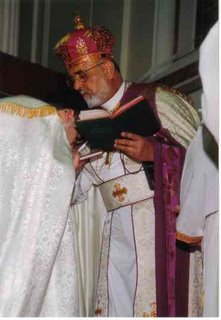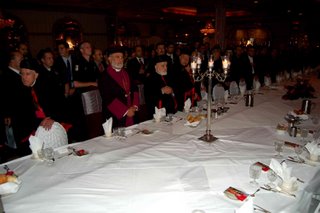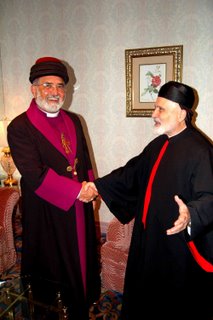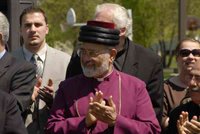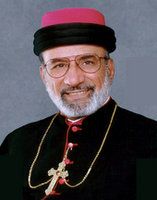
In manuals of church history written thus far, the Christian Church has been hitherto divided into two fundamental parts, namely, East and West – Orthodox East and Latin West, that is. However, this in fact does not do justice to the glories of the Eastern portion of the Church of Christ, which has been basically characterized as and wholly identified with the ‘Eastern Orthodox’ and has been identified with the Greek-speaking Church. The recent film which all of us, or most of us, witnessed during the Easter season was the Passion of the Christ, produced by Mel Gibson. The importance of this film, no matter what one may think of its content or script, was the fact that it made use of the original languages of that age which made the film more unique, and it brought forth a rejuvenated interest in the language of our Lord – which is still used to this very day in the form of its daughter-language known as Syriac – a language utilized to this very day by one of the more glorious of the ancient eastern Churches of yester-year – the Assyrian Church of the East.The origins of the Church of the East, variously known as the ‘Assyrian Church,’ ‘Church of Persia,’ ‘Nestorian Church’ etc. may be news to other Christians at large. The history of the expansion of Christianity from the Holy City (Jerusalem) westward is commonly known and well-chronicled. However, it is the spread of the Gospel eastward and particularly to the other parts of the Near East that is not so well-acquainted with. It is the humble aim of this brief outline to expose the history of the apostolic foundation of this once-glorious Church, and to whet the appetite of church historians, and especially that of the children of this once-glorious and most missionary-minded of all the Churches of Asia.
Apostolic Origins in Light of the New TestamentThe evangelist Matthew mentions at the very beginning of his Gospel an event which marked the marvelous event of the birth of Christ, namely the coming of the Magi – the Wise Men of the East. The Gospel-writer narrates: “Now when Jesus was born in Bethlehem of Judea in the days of Herod the king, behold, there came wise men from the east to Jerusalem, saying: ‘Where is he that is born King of the Jews? For we have seen his star in the east, and are come to worship him’” (Mt 2:1-2). The evangelist continues that once having reached Judea, and having encountered Herod the tetrarch, these wise men had finally reached the Christ-child: “When they had heard the king, they departed; and lo, the star, which they saw in the east, went before them, till it came and stood over where the young child was” (Mt 2:9). According to St. John Chrysostom (d. 407): “The Incarnate Word on coming to the world gave to Persia, in the persons of the Magi, the first manifestations of His mercy and light... so that the Jews themselves might learn from the mouths of Persians of the birth of their Messiah.” According to tradition, the Persians had learned of the coming of the Messiah from the prophecies of Zoroaster, who was said to have been a disciple of the prophet Jeremiah during the captivity of the northern kingdom of Israel by the Assyrians in 721 B.C. Thus, we see that the prophecy concerning the coming of the promised Messiah was known in the land of the Persians as well. In fact, the great patriarch of the Church of the East, Timothy I (780-823) asserted that it was exactly these magi who preached the coming of the Messiah in the land of the Persians.The second major New Testament event which we cite with regard to the apostolic origins of the Church of the East is the fulfillment of the prophetic event of the Pentecost which took place in the Upper Room 50 days after the Resurrection. Being one of the three ‘pilgrim feasts,’ many Jews were to be found in Jerusalem coming from different parts of the Roman Empire, and also from beyond the limes of the Roman Empire. St. Luke, the evangelist and historian of the Primitive Church, narrates in the Acts of the Apostles: And there were dwelling at Jerusalem Jews, devout men, out of every nation under heaven. Now when this was noised abroad, the multitude came together, and were confounded, because that every man heard them speak in his own language. And they were all amazed and marveled, saying one to another. Behold, are not all these which speak Galileans? And how hear we every man in our own tongue, wherein we were born? Parthians, and Medes, and Elamites, and the dwellers in Mesopotamia, and in Judea, and Cappodocia, in Pontus, and Asia…(Acts 2:5-9).
Thus, we see that there were Jews present in the Holy City for the feast of the Pentecost (Feast of Weeks) who heard the preaching of the apostles, and especially the discourse by Peter, and received the Gospel of Jesus Christ “…then they that gladly received his word were baptized; and the same day there were added unto them about three thousand souls” (Acts 2:41). It is highly likely that these Persian Jews took back with them to their homeland the Gospel of Jesus Christ, thus sowing the seeds of the Gospel among their fellow Jews in the Diaspora as well as among the non-Jewish inhabitants within the Persian Empire, which was at that time the second superpower after the Romans.Although the Book of Acts follows the journey of St. Paul westward to Antioch and beyond, where the believers were first called ‘Christians’ (Acts 11:26), the expansion of the faith beyond the limits of the Roman Empire is not chronicled in Luke’s chronology. There are, however, a number of secondary sources that chronicle the spread of the Gospel to the Aramaic-speaking peoples of Mesopotamia who identify themselves as being the descendents of the ancient Assyrians and Babylonians who later adopted the language of the Aramean nomads, i.e. Aramaic, that settled in their lands sometime in the ninth century B.C.
The Early Christian History of EdessaThe stage for the setting of Christianity in the Syriac-speaking East is the city of Edessa (modern-day ‘Urfa’ in southeastern Turkey), the capital of the small kingdom of Osrhoene. Located on a tributary of the mighty Euphrates, it laid on one of the greatest trade routes to the East that went through the ‘Great Syrian’ desert to the south and the mountains of Armenia to the north.The city already existed before the Seleucid period (336-323 B.C.) and was re-founded by the Greeks who gave it the name of ‘Edessa,’ or ‘Urhai’ in Syriac (the root of the Greek ‘Osrhoene’ and the Turkish ‘Urfa’). It was ruled by a series of monarchs of Arab origin and became the capital of an independent city-state sometime in 130 B.C. with the defeat of the Seleucids by the Parthians who pushed the Greeks back into Asia Minor, and later became a Roman colony in 214 A.D. By 258 or 259, it was already a part of the Persian Empire under the Sassanids.King Abgar Ukkama (‘The Black’) reigned over the kingdom of Edessa from 4 B.C. to 50 A.D., however it is only with Abgar IX (179-214 A.D.) that there is any certainty concerning the reception of Christianity by the monarch. According to others, it is Abgar ‘VIII,’ since a coin of this monarch issued between 180 and 192 depicting his head shows a cross on his headdress.The so-called Chronicle of Edessa, a sixth-century Syriac document originally penned in Estrangelo, narrates that in a flood which damaged the city of Edessa in 201 the Christian temple was destroyed.
The Doctrine of AddaiAn important document narrating the establishment of Christianity in the Syriac-speaking East is the so-called Doctrine of Addai the Apostle, written in Syriac and come down to us in its final form sometime between 390 and 400, and which contents are certainly earlier than the date of its writing. This document chronicles the coming of Addai (Thaddaeus) believed to have been one of the Seventy-Two disciples (cf. Lk 10:1) sent by Thomas, one of the Twelve, to the small kingdom of Osrhoene or Edessa (in Syriac Urhai), some 160 miles east of Antioch. The Doctrine of Addai recovers the letter of Abgar to Jesus and the Lord’s response, promising eternal life to the king and the inhabitants of his suzerain kingdom for believing in Christ’s name, and also that the enemies of the realm should not prevail over it. According to the tradition, the apostle Addai came to Edessa in the year 343 of the Greeks (32 A.D.),…in the reign of our master Tiberius, the Roman Emperor, in the reign of king Abgar, the son of king Ma’nu in the month of October, and early on the twelfth day, Abgar Ukkama sent Marihad and Shamshagram, chieftains and honored men of the kingdom, and with them Hannan, the faithful archivist, down to the city called Elev-theropolis but in Aramaic Beth Gubrin, to the Venerable Sabinus, son of Eustorgius, a representative of our master, the emperor, he who ruled over Syria and over Phoenicia and over the whole country of Mesopotamia.
The emissaries are sent to the Holy City to see Christ and record his deeds to Abgar, and …when Marihab, Shamshagram and Hannan, the archivist, saw these men, they too, went with them to Jerusalem, they saw many men coming from far away to see Christ, because his wonders had been rumored to distant countries. And when Marihab, Shamshagram and Hannan, the archivist, saw these men, they too, went with them to Jerusalem. And when they came to Jerusalem they saw Christ and they rejoiced together with the crowd that was attached to him, and they saw the Jews, too, standing in groups, and meditating on what they out to do with him, because they were puzzled, seeing numbers of their own people ready to profess him, and they stayed in Jerusalem ten days. And Hannan, the archivist, wrote down what he, himself, saw of the doing of Christ, besides all the rest that he had done, before their coming to Jerusalem. And they set out and came to Edessa.
The emissaries of the Edessene king continue to recount all that they saw Christ do and say in the Holy City. When the king had heard about all of the marvelous deeds of Christ he sent them on another journey to Jerusalem:And when king Abgar heard this, he was much surprised and astonished, he and his great men who stood before him. And Abgar said to them: ‘These mighty acts are not of man, but of God because nobody but God only can call the dead to life again.’ And Abgar desired to set out to Palestine in order to see with his own eyes all the doing of Christ. But as he could not go over the land of the Romans, not being his possession, and as he did not want to be the cause of bitter enmity, he wrote a letter and sent it to Christ by means of the hand of Hannan, the archivist, and he set out from Edessa on the 14th day of Adar (March) and he entered into Jerusalem on the 12th day of Nisan (April) on the fourth day of the week. And he found Christ in the house of Gemaliel, the high priest of the Jews…
The primitive church historian Eusebius bishop of Caesarea (ca. 264-340) narrates what many scholars have called the ‘legendary’ letter of Abgar V, king of Edessa, to Christ seeking healing from his illness. The letter is quoted in Eusebius’ Historia Ecclesiastica (I, 13:5-10) and preserves the Greek recension of the letters. Thus, Eusebius’ Greek source and the Syriac Doctrine of Addai, constitute the twofold source of the letters of Abgar and Christ. The first of the letters is that of Abgar to Jesus:Abgar Ukkama, the Toparch, to Jesus the good Savior who has appeared in the district of Jerusalem, greeting. I have heard concerning you and your cures, how they are accomplished by you without drugs and herbs. For, as the story goes, you make the blind recover their sight, the lame walk, and you cleanse lepers, and cast out unclean spirits and demons, and you cure those who are tortured by long disease and you raise dead men. And when I heard all these things concerning you I decided that it is one of the two, either that you are God, and came down from heaven to do these things, or are a Son of God for doing these things. For this reason I write to beg you to hasten to me and to heal the suffering which I have. Moreover, I heard that the Jews are mocking you, and wish to ill-treat you. Now I have a city very small and venerable which is enough for both.
Jesus then replies to Abgar by way of the king’s emissary and scribe Hannan (‘Ananias’ in the Greek form):Blessed are you who did believe in me not having seen me, for it is written concerning me that those who have seen me will not believe in me, and that those have not seen me will believe and live. Now concerning what you wrote to me, to come to you, I must first complete here all which I was sent, and after thus completing it be taken up to him who sent me, and when I have been taken up, I will send to you one of my disciples to heal your suffering and give life to you and those with you.
Eusebius of Caesarea is said to have visited Edessa sometime in 323, where he is alleged to have found the records of the letters in Syriac and which he most probably made use of as sources for his history of the events. He states with regard to the Abgar who heard of the preaching and divine healings wrought through Christ, “In this way King Abgar, the celebrated monarch of the nations beyond the Euphrates, perishing from terrible suffering in his body, beyond human power to heal, when he heard much of the name of Jesus and of the miracles attested unanimously by all men, became his suppliant and sent to him by the bearer of a letter, asking to find relief from his disease.”The Historia Ecclesiastica of Eusebius then continues to narrate the outcome of the letters and the mission of Addai, who is identified with Thaddeus one of the Twelve in the Syriac version (cf. Mt 10:3) and one of the Seventy-Two in the Eusebian tradition,making use of a Syriac source:Now after the ascension of Jesus, Judas who was also Thomas, sent Thaddaeus to him as an Apostle, being one of the Seventy, and he came and stayed with Tobias the son of Tobias. Now when news of him was heard, it was reported to Abgar, ‘An Apostle of Jesus has come here, as he wrote to you.’ So Thaddaeus began in the power of God to heal every disease and weakness so that all marveled.
And when Abgar heard the great and wonderful deeds that he was doing, and how he was working cures, he began to suspect that this was he of whom Jesus had written saying, ‘When I have been taken up, I will send to you one of my disciples who will heal your suffering.’ So he summoned Tobias, with whom Thaddaeus was staying, and said, ‘I hear that certain man of power has come and is staying at your house. Bring him to me.’ Tobias came to Thaddaues and said to him, ‘The toparch Abgar summed me and bade me bring you to him in order to heal him.’ And Thaddaeus said, ‘I will go up since I have been miraculously sent to him.’ These things were done in the 340th year [29 A.D.]
It is clear from the tradition that Addai was a Jew and that he had close ties with other Jews residing at Edessa. The fact also remains that there existed other nations (‘Gentiles’) in the small kingdom, and the vast majority held on to the old Assyro-Babylonian religion of their forefathers, with minimal influences from the Hellenic culture. The same is true of the city of Harran near Edessa, which enjoys close ties to the Abrahamic tradition; it too enjoyed pagan religion and cult. Syriac was the spoken and written language of the kingdom, as the many tombstone and monumental inscriptions (some of which pre-date the Christian era) indicate.
The multi-cultural city of Edessa was thus early-on evangelized by apostles from Jerusalem, and the existence of Jews in the city provided the crucible for the growth of the faith of Christ, and the existence of merchants and silk-traders provided the personnel for the apostolic work and the spreading of the faith. According to L. Tang: “Even in the country of Assyrians, new converts taught their sons and daughters of their own people and built houses of prayers there secretly, through the danger of fire-worshippers and the adorers of water.”Even though the letters were condemned as ‘apocryphal’ in the West by Pope Gelasius in 494, the Syriac-speaking churches of the East certainly considered them to be founded upon historical truth.
The famed theologian St. Ephrem the Syrian (ca. 306-373) refers to the Abgar tradition, though not necessarily to the letters themselves, in his Testament: “Blessed is the town in which you dwell, Edessa, mother of the wise; by the living mouth of the Son has it been blessed by the hand of his disciple. That blessing will dwell in it until the holy one reveals himself.”The portrait of Christ which Ananias is reported as having brought back with him to Edessa was known to have been brought to Constantinople from Edessa in 944 A.D. However, the letters are referred to in a letter addressed to Augustine of Hippo in 429, and are also known to Jacob of Serug (451-521) and in the chronicle of Joshua the Stylite – which refers to the event of warding off the Persian king Kawad from besieging Edessa in 503 A.D.
The Testimony of BardaisanAnother early witness to the Abgar tradition is the Book of the Laws of Countries written by the Gnostic Bardaisan (154-222)in Syriac sometime at the beginning of the third century. Bardaisan was born in 154 at Edessa from supposedly pagan parents, and was brought up by a pagan priest. Sometime in 179 A.D., at the age of 25, he became a Christian while one day passing by the church founded by Addai, where he heard the Scriptures read and interpreted; he was soon baptized by the bishop of Edessa Hystasp, and ordained deacon by him.Bardaisan refers to the Abgar tradition which would certainly have been common knowledge at Edessa. With reference to the abandonment of the rite of castration in the worship of the Mother Goddess cult at Hierapolis (Mabbug), Bardaisan states: “…when Abgar the king believed [in Christ] he decreed that anyone who castrated himself should have his hand cut off. And from that day on to this time, no man castrates himself in the country of Edessa.” This is certainly the same Abgar who is credited with being involved in the evangelization of Edessa. It seems that Bardaisan was educated with the monarch Abgar VIII (176-213), and was favored at the royal court; it is from his acquaintance with Abgar that Bardaisan makes the assertion concerning the evangelization of Edessa. Bardaisan also mentions the presence of Christians in Parthia, Gilan (southwest of the Caspian Sea), Bactria (between the ranges of Hindu Kush and the Oxus), Persia, Edessa and Media, and by the year 200 A.D. knew of the presence of Christians over the known parts of Asia.
The Evangelization of AdiabeneThe other major territory of missionary activity which directly concerns the history of the Church of the East is the evangelization of Adiabene in northeastern Mesopotamia, some four hundred miles east of Edessa. In the ancient world, Adiabene was historically known as ‘Assyria.’ The well-known Roman topographer Strabo, writing his famous Geographica in 20 A.D., mentions Assyria and Parthian Persia east of Asia “whose eastern provinces touched the borders of India.”He refers to the strip of land exactly between the rivers Tigris and Euphrates as ‘Assyria,’ and all that is west of that he terms ‘Syria.’In 247 B.C. the third Persian dynasty known as the ‘Parthians’ came onto the scene by re-conquering Persia from the Greeks and made Persia Asian again by capturing the Seleucid emperor at Babylon in 140 B.C. The Parthians had captured Edessa from the Romans, and later made Seleucia-Ctesiphon (on the Tigris, north of old Babylon) their capital. They also had the policy of making petty ‘client-kingdoms,’ among them being Edessa, Adiabene and Armenia. Adiabene was farther east of Edessa (on the upper waters of the Tigris near the old capital of Nineveh) and “its capital, Arbela (modern-day Erbil), was to become the center for Christian missionary advance into central Asia.”There was a Jewish community at Adiabene, considered stronger than that of Edessa, which saw in the first century A.D. the conversion to Judaism of Helena, the queen of Adiabene, along with her two sons. There also existed a strong Jewish community in Nisibis as well, probably the strongest in the region. Furthermore, the cities of Edessa, Nisibis and Adiabene were connected by the silk-road, and the Jewish, Christian and pagan constituencies of these cities lived side-by-side, and the strong Jewish presence allowed for the swift progress of Christianity in these merchant centers.According to S.H. Moffett,
“…like Edessa, Arbela was one of the earliest Christian centers in oriental Asia. One theory…holds that the faith came first to Adiabene and from there was carried back west to Edessa,”rather invalidating the generally-held theory that the first Christian missionaries came to Edessa from Jerusalem itself.
Scholars, however, generally agree that the new Christian faith was preached and gained more followers in the villages of the Adiabene region rather than in the metropolis itself.The famous Jewish historian Flavius Josephus in his Jewish Antiquities (XX, 20) relates the story of the conversion of the royal family of Adiabene to Judaism. Josephus narrates that the king of Adiabene married his sister Helena, and sent his son Ezad to remain with Abednergal the king of Karkha d’Meshan near the Persian Gulf.Ezad later succeeded his father to the throne of Adiabene in 36 A.D., thus becoming a contemporary of Abgar Ukkama, in the meantime having married the daughter of his host. The interesting part of the story, however, is that while Ezad was still at Meshan, a certain Jewish merchant named Ananias had converted some women in the royal court to Judaism. Later, Helena the queen mother had already converted to Judaism independently from the influence of her son and Ananias. Ezad later was granted the governance of Nisibis by the Parthian emperor Walagash I, who later opposed him. Both Ezad and his mother Helena were buried at Jerusalem, where their tombs are to be found to this very day. This story later gets interwoven with the Abgar tradition of Edessa, and the conversion of Helena of Adiabene is later confused with the much later story of the finding of the Cross by Helena the mother of Constantine.In the Arabic legend about Jesus (Rosat al-Safa), the Abgar story is retold with different characters. The King of Nisibis Nersai (rather than the ‘Ezad’ of Josephus) invites Jesus to visit him, who is in then accompanied by Thomas, Simon and James. In fact, the name of the king of Adiabene at the time of Abgar Ukkama was in fact one Narseh who is known as the king of the ‘Assyrians’ (Adiabene). According to the legend, Thomas was followed at Edessa by Addai, accompanied by his disciples Aggai and Mari, who arrived three years after the Ascension of Christ and who are said to have gone as far as the ‘great lakes of the east’ converting the nations to Christianity. Once returned to Edessa, they found the Christian king Abgar dead and succeeded by his son Ma‘nu, who seems to have been a heathen. He is supposed to have killed Addai on July 3 (ironically the feast of St. Thomas), and was buried in the church which Addai himself had built. Addai is also believed to have been the apostle of the region of Adiabene, modern-day Arbel. With the presence of a great Jewish diaspora, and the fact that Syriac was also the tongue of Adiabene, the connection with missionaries from Edessa is almost indubitable. Whether by Addai himself or a disciple, the tradition points to Edessa as its source of evangelization. The infamous document known as the Chronicle of Adiabene, attributed to Mshikha-zkha and perhaps written sometime between 550-569, traces the line of apostolic succession of the first 20 bishops of Adiabene from 104 to 511 A.D.The first bishop was Pqida, who in turn is connected to the earlier evangelistic efforts of Addai at Edessa, and according to the Chronicle it was Addai himself who ordained Pqida as bishop.Pqida is reported as having been converted to Christianity from Zoroastrianism by witnessing a miracle brought about by the apostle Addai from Edessa having raised a dead girl to life. Thus, the Chronicle makes no mention of the other disciple of Addai – namely Aggai and Mari – and directly links Pqida to Addai the apostle of Edessa.Though the existence of an episcopacy in Adiabene in the first Christian century may be debatable, we may conclude that there is no reason to seriously doubt the conversion of Adiabene – already a commercial center enjoying a strong Jewish and pagan presence – or that one of its earliest converts to Christianity was a certain ‘Pqida.’ Among the other bishops mentioned in the Chronicle is a certain Semsoun who is supposed to have been martyred in 117 or 123, after Trajan had defeated the Persian monarch Khosraw sometime in 116. However, the Parthians were generally tolerant of the other religious constituencies in the realm, and it is only later under the Sassanids that persecution of the Christians is well documented. However, other Syriac documents seem to differ on who the apostle of Adiabene was. The Syriac Doctrina Apostolorum (‘Doctrine of the Apostles’) gives the credit to Aggai, the disciple and successor of Addai, as being the one who brought the Gospel to Adiabene.The much later history of St. Mari one of the disciples of Addai, also known as the Acts of Mari, records him as the missionary of Adiabene, as well as that of the twin royal city of Seleucia-Ctesiphon in the late first Christian century.Aggai succeeded his master Addai, and is said to have preached “over the entire country of Persia, also in Assyria, Media, Babylonia and many other places, and he traveled to the boundaries of India.”He too was martyred under Ma‘nu after refusing to weave royal garments for the pagan monarch. The Doctrine of Addai states that “Aggai died in consequence of the misdeed of the prince, and too sudden to ordain Palut by imposition of hands.” The tradition then goes on to state that Palut fled to nearby Antioch where he was ordained by Serapion, the bishop of the city, and the acts of the martyrdom of Sharbil and Barsamya attest to the episcopal career of Palut. Although the accounts of these Edessene martyrs are spurious, it is known that the great persecution ordered by the Roman Emperor Diocletian in 303 took its toll in the ‘blessed city’ of Edessa. However, it was the villagers rather than the city dwellers that felt the sharpest sting of the persecution. The Doctrine states that Aggai, Palut, Barshlama and Barsamya:ministered with [Addai] in the church which he had built…A large multitude of people assembled day by day and came to the prayers of the service and to [the reading of] the Old Testament and the New [Testament] of the Diatessaron. They also believed in the resurrection of the dead…They kept also the festivals of the Church at their proper season…Moreover, in the places round about the city, churches were built and many received from [Addai] the hand of priesthood. So the people of the East also, in the guise of merchants, passed over into the territory of the Romans in order to see the signs which Addai did. And those who became disciples received from him the hand of priesthood, and in their own country of the Assyrians they found disciples, and made houses of prayer there in secret from fear of those who worshipped fire and adored water.
The mention of the Christians of ‘the country of the Assyrian,’ which certainly refers to Adiabene, having to practice their religion in secret seems to indicate a date after 226 A.D. when the Parthian dynasty fell to the intolerant Sassanids.The Doctrine also heavily supports the theory that Edessa – and consequently its dependents in nearby Adiabene and Nisibis – was ecclesiastically dependent on the primatial see of Antioch. According to the Doctrine:…because he [Aggai] died suddenly and quickly at the breaking of his legs, he was not able to lay his hands upon Palut. And Palut himself went to Antioch, and received the hand of priesthood from Serapion, bishop of Antioch, the same Serapion who also received the hand from Zephyrinus, bishop of the city of Rome, [who was himself] of the succession of [those who had received] the hand of priesthood of Simon Peter, who had received it from our Lord…
One of the more famous Christians of Adiabene and “…first verifiable historical evidence of Christianity as far east in Persia as Adiabene” was the philosopher and Biblicist Tatian (120-175)who refers to himself as being from ‘Assyria,’ hence the Latinized form of his name Tatian Assyrus. According to S.H. Moffett, “This remarkable biblical scholar, linguist and ascetic was born of pagan parents in the ancient Assyrian territory of northern Mesopotamia (modern-day Iraq),” that is in Adiabene, and was a convert to Christianity, later becoming a disciple of Justin Martyr.Early on he learned Greek, wrote his apology Against the Greeks sometime in 172 before settling in Edessa, or according to others he went back to his native Adiabene, “or somewhere near it east of the Tigris ‘in the midst of the Rivers.’”He is the famous compiler of the Diatessaron, or ‘harmonized’ Gospel – which he probably composed in Syriac and was used by all of the Syriac-speaking Churches in the East up to the time of its suppression by Rabbula the West Syrian bishop of Edessa sometime after 411 A.D.
The St. Thomas TraditionIntimately bound up with the Addai tradition of the evangelization of Edessa is the preaching of St. Thomas. Early on, Thomas – one of the Twelve – was considered to be the one who sent Addai to Edessa from the Holy City. A Syriac document probably written at Edessa itself at the beginning of the third century (ca. 200 A.D.) is the Acts of Judas Thomas. The Acts, which are the “oldest narrative account of a Church in Asia beyond the border of the Roman Empire,”narrate the missionary career of Thomas, who was certainly the apostle of the Parthians, Medes and other peoples east of Parthia. According to the Syriac tradition of the Acts, it is Judas Thomas (which may be the source of the identification of the Edessene Addai with the apostle ‘Judas Thaddaeus’ of the Twelve) who was the apostle of Edessa, and is sometimes referred to as ‘Thaddaeus who is Thomas’ or simple ‘Judas who was also called Thomas.’Thomas was later introduced into the story of Abgar, although “nowhere in the earlier versions of the proselytization of Edessa is it claimed that St. Thomas himself came to the city.”The association of the two traditions concerned with Thomas from the Twelve and Thaddaeus-Addai “integrated the evangelization of Edessa within the direct apostolic tradition.”The very early Hymn of the Soul contained in the Acts, states that the prince of Maishan, on following the trade route that connected Adiabene in the east to Edessa and Nisibis in the West to India and Fars had “…quitted the East and went down…I passed through the borders of Maishan, the meeting place of the merchants of the East, and I reached the land of Babylonia.”Another tradition originating in Alexandria around the middle of the third century actually has Thomas going into the Parthian Empire rather than to Edessa. This tradition is backed by Origen (d. 251) in his Commentary on Genesis (Chapter 3), who is in fact the first to mention it, and is also found in Eusebius’ Ecclesiastical History (3:1) and in the Syriac Clementine Recognitions.Thomas is also considered the apostle of India by many of the earliest ecclesiastical sources. However, the Alexandrine tradition initiated by the missionary Pontaeunus (180/190 A.D.) – who was sent by Demetrius the bishop of Alexandria on a mission to India – it was Bartholomew (the ‘Nathaniel’ of the New Testament) who was the apostle to India, and who also brought with him a Hebrew (Aramaic?) copy of the Gospel of Matthew; this information is witnessed to by both Eusebius and Jerome.Since Bartholomew is usually considered the apostle to Armenia, Arabia and Persia, it is extremely out of the ordinary. In any case, it is certain that before the end of the second Christian century a living community of faithful was to be found in the south of the Indian sub-continent which traced their apostleship – according to the vast testimonies of the tradition – to Thomas.
The Witness of Egeria the Iberian (ca. 384 A.D.)
A very important witness to the tradition of the apostolic activity and missionary work of Thomas one of the Twelve is the so-called Journal of the late fourth century Iberian nun Egeria. Egeria’s famous Journal records her pilgrimage to the Holy City and the various other pilgrimage-sites visited by the Spanish nun on her journey. She recalls that …no Christian who has achieved the journey to the holy places and Jerusalem misses going also on the pilgrimage to Edessa. It is twenty-five staging posts away from Jerusalem. But Mesopotamia is not so far from Antioch. So, since my route back to Constantinople took me back that way, it was very convenient for me at God’s bidding to go from Antioch to Mesopotamia…(17:1)
Three years after her arrival in Jerusalem she goes to Mesopotamia, to Harran the land of Abraham and to Edessa the ‘blessed city:’
But God also moved me with a desire to go to Syrian Mesopotamia [the Greek translation of the Padan Aram of Gen 28:1 which Egeria uses in reference to Edessa]. The holy monks there are said to be numerous and of so indescribably excellent a life that I wanted to pay them a visit; I also wanted to make a pilgrimage to the martyrium of the holy apostle Thomas, where his entire body is buried (17:1)The Edessene connection with Thomas the apostle goes back to the Acts of Judas Thomas. Since the time of the writing of the Acts around 200 A.D., it was believed that notwithstanding the widely-accepted tradition that he died in India, his body was removed to Edessa, certainly before the middle of the fourth century when Ephrem penned his Nisibene Hymns (42), who mentions the presence of the apostle’s bones in Edessa. The other component of the Edessene connection, around the time of Egeria’s Journal ca. 384 A.D., was that Thomas – rather than Addai – was believed to have been sent by Christ to Edessa.Recalling the existence of the Abgar tradition, Egeria states: “It is at Edessa, to which Jesus, our God, was sending Thomas after his ascension into heaven, as he tells us in the letter he sent to King Abgar by the messenger Ananias. This letter has been most reverently preserved at Edessa where they have this martyrium” (17:1). Egeria recounts the story of her arrival in Edessa and her meeting the bishop of the city. She also recalls the many martyria or shrines built over the martyrs’ tombs and the consecrated monks who took care of these shrines, which by the year 449 A.D. numbered some 90,000 in the hills of Edessa.The church of St. Thomas was built sometime between 373 and August of 394 when the coffin of the apostle was moved to his own church:As soon as we arrived, we went straight to the church and martyrium of holy Thomas; there we had our usual prayers and everything which was our custom in holy places. And we read also from the writings of holy Thomas himself [certainly the Syriac Acts of Judas Thomas]. The church there is large and beautiful, and built in the new way – just right, in fact, to be a house of God…I saw a great many martyria [martyrs’ shrines] and visited the holy monks, some of whom lived among the martyria, whilst others had their cells further away from the city where it was more private. (19:2-4)
The bishop of Edessa takes Egeria to visit the pilgrim sites present in the city. The foremost among them being the palace of Abgar, built in 205-206 A.D., and a huge marble likeness of the famed monarch:So first of all he took me to the palace of King Abgar, and showed me a huge marble portrait of him. People said it was an excellent likeness, and it shone as if it was made of pearl. The look on Abgar’s face showed me, as I looked straight at it, what a wise and noble man he had been, and the holy bishop told me, ‘That is King Abgar. Before he saw the Lord he believed in him as the true Son of God.’ Next to this portrait was another of the same marble; he told me it was the king’s son Magnus, and he too had a wonder face (19:6).
The ‘holy bishop’ of Edessa recounts the whole story of letter of Abgar to Christ and reference is also made to the attack of Edessa by the Persians in 259 A.D., which seemed to contradict the promise of Christ that the city would never succumb to its enemies, as contained in the Greek recension of the letter of Christ to Abgar.
The holy bishop told me this about it:
‘King Abgar wrote a letter to the Lord, and the Lord sent his answer by the messenger Ananias; then, quite a time after, the Persians descended on this city and encircled it. So at once Abgar, with his whole army, took the Lord’s letter to the gate, and prayed aloud: ‘
Lord Jesus,’ he said, ‘
You promised us that no enemy would enter this city. Look now how the Persians are attacking us!’ With that the king held up the letter, open in his hands, and immediately a darkness fell over the Persians who were by then close outside the city walls. It made them retire three miles away, and the darkness was so confusing to the Persians that they found it difficult to pitch camp and carry out patrols even at three miles’ distance from the city (19:8-9).
The bishop is narrating the story of the attack of Edessa by the Persians under Shapor I in 259 A.D., and this late-fourth century witness most probably exhibits an earlier tradition held in the city, or one approved by the bishop himself. The pilgrim Egeria was also shown the gate of the city through which the messenger Ananias entered bringing in the letter of Christ to Abgar, as well as the tomb of Abgar’s family. The bishop also gave Egeria a copy of the Lord’s letter, which seems to have been a popular souvenir for the pilgrims to the city, containing the promise of Christ for the city which was not to be found in the Eusebian version. The Iberian nun spent three day in Edessa and then headed for the near-by city of Harran, the city of Abraham, which was also a pilgrimage site for the numerous monks of Mesopotamia which Egeria notices with interest.Further minor documents, such as the Acta Maris, or the Acts of Mar Mari are of a much later period and describe the missionary activity of Mari, the disciple of Addai, into Seleucia-Ctesiphon which became the primatial see of the Church of the East in 280 A.D., under its first documented archbishop Mar Papa who is well-known for his work of effecting the centralization of authority of the Persian episcopate in the person of the bishop – now archbishop (and later ‘catholicos’) – of the Persian royal twin-cities. The missionary activity of Mari reaches its peak in the end of the 80’s of the first Christian century, and the evangelization of the royal-cities is also linked to the mother Church at Edessa by the mere fact that it was Addai who sent his disciple Mari deep into Persian territory. According to the Acts, Mari is supposed to have founded over 300 churches or communities, and is said to have been buried at Deir Qunni, which was known as one of the foremost pilgrimage sites and ‘basilicas’ of the patriarchal see. However, even though this tradition cannot be corroborated by any documentary evidence outside of the Church’s tradition and later documents, it nonetheless demonstrates the importance of the oral tradition in order to attempt to explain the origins of what has been called the once most missionary-minded Church of all Asia.It has been the humble aim of this presentation to look at the apostolic origins of this Church which has given countless martyrs for Christ, and which was once an important – albeit isolated – component of the Church of the Church of Christ, the Church of the apostles and martyrs.
© Assyrian Church Of The East. All Rights Reserved.Designed & Powered by Assyrian Enterprise

